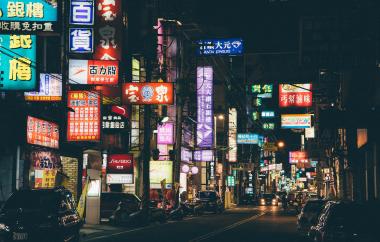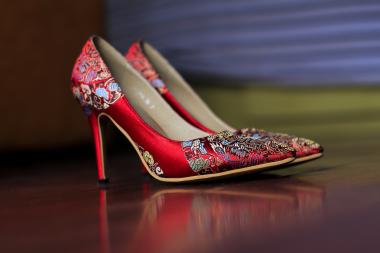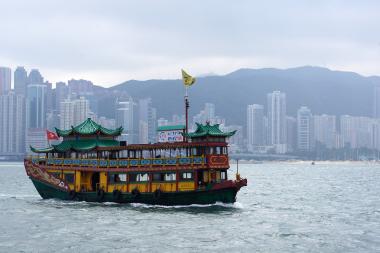CHINA'S CLOTHING COMPANIESS REPOSITION THEMSELVES
- AUTOMATION AND STRONGER FOCUS ON THE DOMESTIC MARKET
Beijing (GTAI) - The Chinese apparel industry is repositioning itself. Increased wage costs force more automation, more customers demanding more quality.
Nowhere else in the world so much clothing is being produced as in China. According to the sector portal http://www.ask.com, alone 22.9 billion pairs of socks were being produced in 2017. This was 4.8 percent more than in the previous year, and the production of jeans amounted to more than 0.6 billion pieces according to information from http://www.chyxx.com, an increase of 5.0 percent.
China is not only the world's largest production nation, but also by far the world's largest export nation in the sector. However, countries such as India, Vietnam, Bangladesh and Cambodia are catching up enormously due to lower wages. As a result, China - measured by its share of world clothing exports - has lost around 5.5 percentage points since 2013, down to only 32.4% in 2017.
| 2008 | 2013 | 2015 | 2017 | |
| World Export | 380 | 468 | 471 | 486 |
| China Export | 120 | 177 | 175 | 157 |
| China's share | 31.6 | 37.9 | 37.1 | 32.4 |
1) SITC Pos.84; 2) Partially estimated on the basis of information provided by the ITC
Source: UN Comtrade, GTAI calculation.
By contrast, Bangladesh (+3.7 points), Vietnam (+2.0 points) and Cambodia (+1.3 points) in particular recorded gains in the period from 2013 to 2017. In absolute terms, Chinese apparel exports fell by 15.6% to USD 157 billion since the record year of 2014 (USD187 billion). No improvement is in sight as exports are stagnating in 2018.
| 2008 | Share | 2013 | Share | 2017 | Share | |
| World Export | 380,000 | 100.0 | 468,000 | 100.0 | 486,000 | 100.0 |
| China | 120,405 | 31.6 | 177,435 | 37.9 | 157,464 | 32.4 |
| ASEAN3) | 29,793 | 7.8 | 42,123 | 9.0 | 61,441 | 12.6 |
| Vietnam | 8,724 | 2.3 | 17,230 | 3.7 | 27,930 | 5.7 |
| Kambodscha | 3,014 | 0.8 | 4,832 | 1.0 | 11,250 | 2.3 |
| Bangladesch | 12,035 | 3.2 | 19,679 | 4.2 | 38,460 | 7.9 |
| India | 10,968 | 2.9 | 16,843 | 3.6 | 18,313 | 4.0 |
| Germany | 18,183 | 4.8 | 19,178 | 4.1 | 22,034 | 4.6 |
1) SITC Pos. 84; 2) partly estimated on the basis of ITC data; 3) excluding Laos and Brunei
Sources: UN-Comtrade; ITC; GTAI calculation
Rising wage costs as investment driver
Due to rising personnel costs throughout the country, manufacturers were and are under considerable cost pressure. With an average hourly wage for a Chinese worker of the equivalent of around USD 5.2 (2017), China has not only left classic emerging markets such as Thailand (USD 2.3) or Mexico (USD 3.9) behind - not to mention India with USD 0.8 - but is already approaching individual European countries (e.g. Greece 2016: USD 6.0).
Companies have met and continue to meet this challenge through increased automation. Between 2015 (9.1 million) and 2017 (7.8 million) alone, the workforce of the textile and clothing industry shrank by 14.3 percent - according to the Chinese statistical office. More and better machines make it possible to say goodbye to the previous labor-intensive production - and thus lower cost pressure with more precise and faster execution. Imports of textile machinery are also benefiting from this. These rose in 2017 by a whopping 34.1 percent year-on-year to nearly USD 3.9 billion.
Germany no longer number one textile machinery supplier
Although Germany lost its position as most important supplier country for textile machinery to Japan, it was still able to increase its deliveries by 28.3 percent to USD 1.1 billion. This corresponded to a supply share of 28.3 percent. Japanese manufacturers achieved a ratio of 30.0 percent with just under USD 1.2 billion (+52.8 percent). Competition from Italy came to only 11.5 percent. The good performance is remarkable due to the fact that a number of German textile machine manufacturers have invested heavily in recent years in the region in order to be able to meet the wishes of Chinese customers more effectively.
| 2015 | 2016 | 2017 | Change | Shares | |
| Total | 3,354 | 2,907 | 3,897 | 34.1 | 100.0 |
| including | |||||
| Japan | 728 | 765 | 1,169 | 52.8 | 30.0 |
| Germany | 1,219 | 851 | 1,101 | 29.4 | 28.3 |
| Italy | 415 | 347 | 448 | 29.1 | 11.5 |
| Taiwan | 206 | 187 | 203 | 8.6 | 5.2 |
| Belgium | 134 | 124 | 173 | 4.0 | 4.4 |
| Switzerland | 104 | 111 | 126 | 13.5 | 3.2 |
*) SITC-Pos. 724
Source: UN-Comtrade; GTAI calculation
Due to the high pressure to modernization Chinese textile machinery imports in the first seven months of 2018 increased by almost 15 percent compared to the previous period. German machine manufacturers in particular benefited from this development, with deliveries increasing by 30 percent in the same period. As Japanese exports of textile machinery to China stagnated at the same time, German manufacturers are likely to take the lead again in 2018.
As the garment exports come under such severe pressure, the industry is now increasingly geared towards the local market. Whereas ten years ago about half of the value of production was exported, today it is only about a third. In fact, the Chinese spent an average of around 4.8 percent of their disposable income or 1,238 Renminbi (RMB; around 183 US dollars; 1 USD = 6.7531 RMB, annual mean rate of 2017) on clothing in 2017, according to the Chinese Statistical Office. With an average disposable annual income of 25,974 RMB and a population of 1.39 billion, this translates into a market volume of approximately USD 255 billion.
China's consumers demand quality and design
This makes the Chinese clothing market one of the largest in the world - and one that is becoming increasingly diversified. Local offerings range from the cheapest mass-produced goods, qualitatively and visually appealing products in the mid-price segment up to luxury and haute couture. Much has changed in the upper price segment in particular. "In the past, the Chinese exported the best qualities, but today they keep them for themselves," says a British sourcing expert who has been working in the Kashmir business for decades, describing the development.
In general, Chinese consumer demand is becoming increasingly sophisticated and differentiated. In addition to the tendency towards recognized brands, an increasing individualization of consumption can also be observed. The question is what fits well, pleases and is also somehow "special". "People in the North used to buy cashmere clothes because they warmed well," explains Cheng Xudong, president of the private Dongrong Group. The design was of secondary importance - and accordingly most of the pieces were "old-fashioned".
"Today, cashmere clothes also look very good," Cheng adds. "That's why it's bought not only in the north, but also in the more southern parts of the country." In general, the middle class in particular is looking for a high-quality lifestyle - and clothing is a part of it. The entrepreneur is convinced that if the textile and clothing industry succeeds in adapting to the higher quality demands of local customers through a technical upgrade and improved design, then the industry will continue to do well in the future.
Additional information
Further information on the economic situation, the sectors, business practice, law, customs, tenders and development projects in China can be found at http://www.gtai.de/china The website http://www.gtai.de/asien-pazifik provides an overview of various topics in the region.
Stefanie Schmitt, Germany Trade & Invest www.gtai.de






